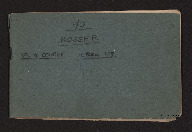Course notes - Lancaster
Title
Course notes - Lancaster
Description
Notes on Lancaster including compass, engines, fuel system, airmanship, hydraulics, pneumatic system, engine handling, icing, automatic pilot, hydraulic propellers and general notes.
Creator
Language
Format
Notebook with handwritten notes and diagrams
Conforms To
Publisher
Rights
This content is available under a CC BY-NC 4.0 International license (Creative Commons Attribution-NonCommercial 4.0). It has been published ‘as is’ and may contain inaccuracies or culturally inappropriate references that do not necessarily reflect the official policy or position of the University of Lincoln or the International Bomber Command Centre. For more information, visit https://creativecommons.org/licenses/by-nc/4.0/ and https://ibccdigitalarchive.lincoln.ac.uk/omeka/legal.
Identifier
MRosserLV745193-190517-30
Collection
Citation
L V Rosser, “Course notes - Lancaster,” IBCC Digital Archive, accessed July 27, 2024, https://ibccdigitalarchive.lincoln.ac.uk/omeka/collections/document/36705.
Item Relations
This item has no relations.

